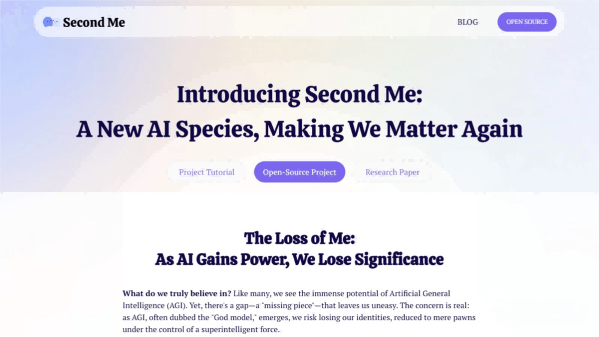Second Me – The AI Identity Model Open-sourced by XinShi Universe
What is Second Me?
Second Me is an open-source AI identity model launched by Mindverse. It supports the creation of fully private and deeply personalized AI agents, representing users’ “true selves.” Second Me offers two interaction modes: Chat Mode and Bridge Mode. Chat Mode enables personalized conversations, while Bridge Mode acts as a connection between users and the world, delivering personalized feedback and enhancing information. Second Me supports local operation, ensuring absolute privacy of user data. By helping users flexibly express themselves in different scenarios, Second Me empowers users to regain control of their identity and data in the AI era.

The main functions of Second Me
- Personalized Identity Creation: Users can upload their memories, experiences, and preferences to train an AI proxy that represents their true self.
- Multi-Role Adaptation: Automatically switches roles according to different scenarios (e.g., work, social, study) while maintaining the user’s core identity.
- Chat Mode: Directly converses with users, providing personalized responses based on personal memory.
- Bridge Mode: Acts as a bridge between the user and the outside world, enhancing demand expression and feedback.
- Privacy Protection: Second Me operates entirely locally, with user data stored on local devices.
- Intelligent Memory Management: Supports rapid pattern recognition, adapts to changes, and evolves together with the user.
The Technical Principle of Second Me
- Hierarchical Memory Model (HMM):
◦ L0 (Short-term Interaction Memory): Processes immediate contextual information for short-term interactions and rapid responses.
◦ L1 (Natural Language Memory Layer): Summarizes and stores important user information, such as personal profiles, preference tags, etc.
◦ L2 (AI-native Memory Layer): Learns and organizes memory based on model parameters, enabling complex reasoning and knowledge retrieval. - Personalized Alignment Architecture (Me-alignment): Leveraging reinforcement learning techniques to transform users’ scattered data into deep, personalized understanding, ensuring that AI accurately captures users’ preferences and behavioral patterns.
- Decentralized Network: Each “Second Me” is an independent AI entity that communicates and collaborates via a peer-to-peer network, ensuring data privacy and security.
- Automated Training Pipeline: Includes steps such as data synthesis, filtering, supervised fine-tuning (SFT), and direct preference optimization (DPO) to ensure efficient model training and personalization.
- Multi-agent Framework: Supports collaboration with other AI agents or expert models, enhancing contextual information and optimizing interaction processes to provide users with more precise services.
- Chain-of-Thought Reasoning: Employs a CoT-style reasoning process during training and inference, enabling step-by-step reasoning and detailed explanations to improve the model’s logicality and accuracy.
The project address of Second Me
- Project official website: https://www.secondme.io/
- GitHub repository: https://github.com/mindverse/Second-Me
- arXiv technical paper: https://arxiv.org/pdf/2503.08102
Application scenarios of Second Me
- Personal Assistant: Help manage schedules, emails and tasks, save time and improve efficiency.
- Career Development: Analyze resumes and skills, provide job-seeking advice, and simulate interview scenarios.
- Social Interaction: Provide social suggestions based on the user’s style and even reply to messages on their behalf.
- Learning Tutoring: Provide personalized learning resources, organize notes, and answer questions.
- Health Support: Record health data, provide health advice, and remind users to take medications and exercise.
© Copyright Notice
The copyright of the article belongs to the author. Please do not reprint without permission.
Related Posts

No comments yet...



